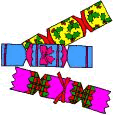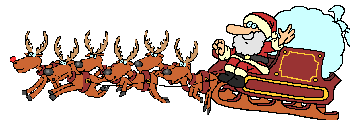CHRISTMAS SYMBOLS
(taken from http://www.santas.net)
Have you ever wondered why children enjoy crackers at Xmas time? What does the mistletoe mean? What are its origins? And what about the typical Christmas colours?
You
can read here to find it out.
*CRACKERS
The crackers date back to the middle of the 19th century and are said
to be of French origin.
 |
 |
In
their earliest form crackers in France were sweets
or bonbons enclosed in twists of coloured paper. An English pastrycook
by the name of Tom Smith saw these bonbons while he was visiting Paris.
Once he had returned home, he started to copy the idea of the wrapper,
but added other small gifts, as well as slips of paper inscribed with
jokes, wise sayings or advice concerning the future. Small toys and
paper hats were other surprises that were included.
Smith's idea did not catch on at first, but on Christmas night 1846
while sitting by his fireplace he heard the crackling of the logs and
came up with the idea of trying to imitate this sound. He did this by
inserting a small explosive in the paper tube, which was set off with
a bang by pulling from either side. This saw the birth of the popular
named 'cracker'.
* THE COIN IN THE PUDDING
The
most exciting moment at the Christmas dinner is finding out who the
lucky person is whose portion of the pudding contains the coin.
Children treasure this custom even if the coin is of no value.

*
KISSING UNDER THE MISTLETOE
The kissing under the mistletoe was originally a belief
that this plant, which stayed green even in winter, could produce and
increase sexual power.
In a few parts of the world it was regarded as being so potent that
it could increase the productivity of the soil, be used as a fertility
drug for cattle, and it was also used as a cure for impotence in humans.
The Druids believed that the mistletoe's magic potency extended far
beyond just conferring fertility. It was thought to cure almost any
disease and was therefore known as 'all healer'. Sprigs
fixed above doorways of homes were said to keep away lightning and many
kinds of evil. As the plant had no roots it was believed that it grew
from heaven.
An old wives tale has it that a girl who had not been kissed under the
mistletoe would be barren. Now it is only an excuse to take innocuous
liberties.

*
POINSETTIA
The poinsettia is named after Joel R. Poinsett, who
served as the USA's first ambassador to Mexico, from 1825-1829. He saw
this indigenous plant with large scarlet leaves encircling small, greenish-yellow
blossoms, which was the Mexican Christmas flower. He sent specimens
back to the USA, where they flourished.

A
Mexican legend tells how the poinsettia became a Christmas flower. A
poor peasant girl was anxious to bring a gift in honour of the Virgin
Mary to the Christmas Eve service. She had nothing to give so she went
with nothing. On the way she met an angel, who told her to pick some
weeds. She did this. As by a miracle they were transformed into the
bright scarlet 'flowers'.Ever since poinsettias have been popular decorations
for churches and homes during the Christmas festival.
* HOLLY

The
evergreen holly symbolises eternal life. This shrub's
most conspicuous features have long been associated with Jesus Christ.
The bright red berries represent the drops of blood He shed on the cross;
their colour also represented the burning love for God present in the
hearts of the faithful. The prickly leaves remind us of the crown of
thorns the Roman soldiers placed on Jesus Christ's head.
* STOCKINGS
A fable of old was that St. Nicholas was concerned about three lovely
sisters. They lived on the outskirts of the city and were poor and destitute.
The saint was determined to save the sisters from a possible life of
prostitution.

One
night it is told that he dropped three pieces of gold through the smoke-hole.
The coins did not fall into the hearth, but fell into the girls stockings,
which had been hanging up near the fire to dry. They were elated to
find the money in the morning. People have hung up Christmas stockings
ever since, hoping to receive a similar surprise.
* THE REINDEER

At
one stage it was thought that Father Christmas (Santa
Claus) lives in the North Pole. In 1925 it was discovered that there
are no reindeer in the North Pole. But there are lots in Lapland, Finland.
So today we know that the reindeer live around the secret village of
Father Christmas and the elves somewhere on the Korvatunturi mountain
in the Savukoski county of Lapland, Finland, which is on the Finnish-Russian
border.
Long ago, Father Christmas and the elves discovered the special formula
of Magical Reindeer Dust which makes them fly. This
dust is sprinkled on each of the reindeer shortly before they leave
on Christmas Eve. It gives them enough magic to fly right around the
world. They can fly very fast: at about the speed of a Christmas light.
Rudolph is the most famous reindeer. He is the leader
of the other 8, whose names are Blitzen, Comet, Cupid, Dancer, Dasher,
Donder, Prancer, and Vixen.

The
names of the 8 reindeer were published by Clement Clark Moore, an American
poet and professor of theology, in his 1822 poem "A Visit
From St. Nicholas." Rudolph was first written about only
in 1939 by Robert May, who included him in a story for the Montgomery
Ward Christmas catalogue. (Of course, the elves knew their names long,
long before Moore and May did.)
Long ago, when Rudolph was just a young deer, his nose
was touched by Christmas Magic, and since this day
his nose has glowed bright red!
Here
you are the song !
If
you click RUDOLPH
you will listen to this famous Xmas song. And these
are the lyrics :
Rudolph the Red-Nosed Reindeer
Rudolph the red-nosed reindeer
Had a very shiny nose,
And if you ever saw him,
You would even say it glows.
All of the other reindeer
Used to laugh and call him names,
They never let poor Rudolph
Join in any reindeer games.
Then one foggy Christmas
eve
Santa came to say:
"Rudolph with your nose so bright,
Won't you guide my sleigh tonight?"
Then all the reindeer loved him
As they shouted out with glee,
Rudolph the red-nosed reindeer,
You'll go down in history
If you are interested in listening to any other XMAS
SONG, you can choose from a wide selection by clicking
ACTIVITIES
1. After reading about all these Xmas traditions and symbols, you are ready to answer these questions. Choose whether these statements are TRUE or FALSE by clicking HERE
2. Now it's time for you to write a LETTER TO SANTA. Once there, scroll down till you see a snowy mailbox !!! Hope you get a reply from Him !!!